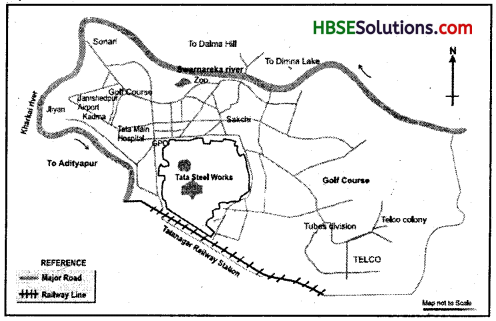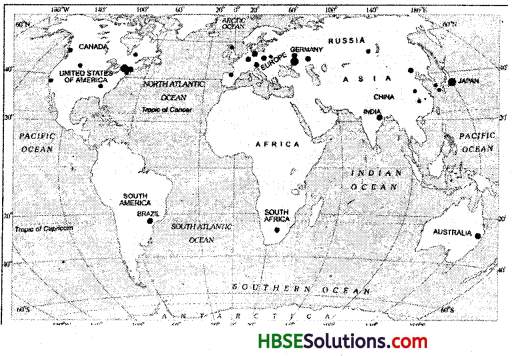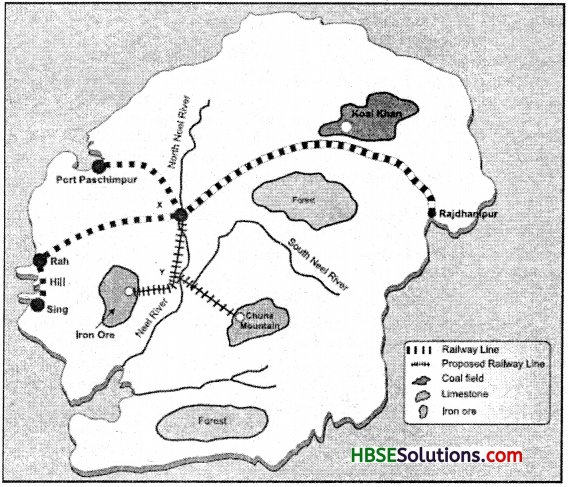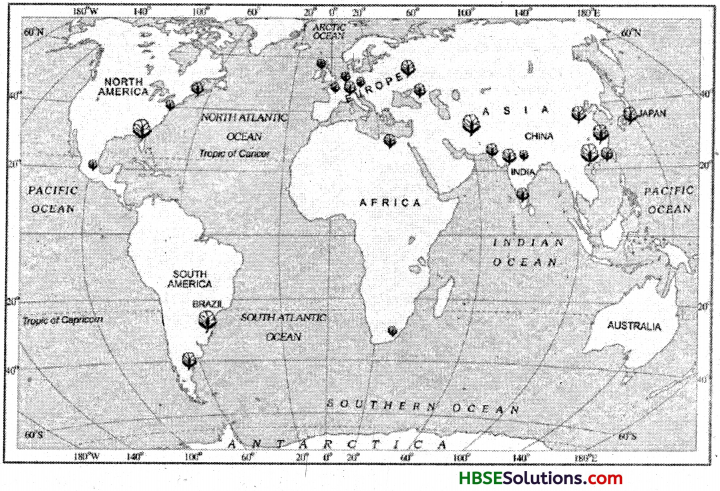Haryana State Board HBSE 8th Class Social Science Solutions Geography Chapter 5 Industries Textbook Exercise Questions and Answers.
Haryana Board 8th Class Social Science Solutions Geography Chapter 5 Industries
HBSE 8th Class Geography Industries Textbook Questions and Answers
ACTIVITY
Question 1.
Give some examples of agro based industries.
Answer:
Food processing, vegetable oil, cotton textile, dairy products and leather industries.
Question 2.
Find out the inputs, outputs and processes involved in the manufacture of a leather shoe.
Answer:
Inputs : Raw materials like leather, labour, cost of land, transport, infrastructure.
Processes : Activities to convert hide into tough leather, spinning, printing.
Outputs : Leather shoes.
![]()
Question 3.
Trace the journey of your shirt from a cotton field to your wardrobe.
Answer:
The shirt which we use is made up of cotton. Cotton is grown in the fields. Cotton buds are plucked and cotton is separated. Cotton seeds also separated and then it is processed for spinning. It is done by hand dr looms. Now machines are used which are run by power. After spinning the weaving process starts and cotton cloth is ready for making shirt which is used by us. In this process power, labour and capital in big amount is used.
Question 4.
What inputs in quantity are required to manufacture one tonne of steel?
Answer:
It requires 8 tonne of coal, 4 tonnes of iron ore and one tonne of lime stone.
LET’S DO
Question 5.
On the outline map of India locate the places that supply raw material to TISCO.

Answer:
The raw material with their source required for TISCO:
- Iron-ore : From Orissa and Chhattisgarh.
- Limestone, dolomite and manganese from Orissa and Chhattisgarh.
- Water is supplied from Kharkai and Subarnrekha rivers.
Question 6.
On the outline map of the world mark the places which provide raw material to cotton textile industry of Osaka.

Answer:
The main raw material of cotton textile industry is cotton. For Osaka textile industry cotton is imported from India, USA and Egypt.
Question 7.
Bangalore has some important public sectors and research institutions. Find out the full forms of the organisations listed below
BEL, BHEL, HAL, NAL, DRDO, ISRO, ITI, nSc, NCBS, and UAS.
Answer:
BEL – Bharat Electrical Ltd.
BHEL – Bharat Heavy Electrical Limited.
HAL – Hindustan Aeronautics Ltd.
NAL – National Aeronautics Ltd.
DRDO – Defence Reaserch and Development Organisation
ISRO – Indian Space Research Organisation
ITI – Industrial Training Institute
IISc – Indian Institute Of Science
NCBS – National Centre for Biological Science
UAS – University Administration and Services
BEL, BHEL, HAL, NAL, DRDO, ISRO, ITI, nSc, NCBS, and UAS.
Question 8.
Collect different types of cloth pieces from the tailor’s shop and classify them under cotton, silk, synthetic and woollen. Find out the raw materials used in their manufacturing.
Answer:
- Cotton – From agriculture
- Silk – Silk worm
- Synthetic – Petroleum products
- Woollen – Sheep
![]()
EXERCISES
Question 1.
Answer the following questions.
(i) What is meant by the term ‘industry’?
Answer:
Industry refers to an economic activity that is concerned with production of goods, extracton of minerals and provision of services.
(ii) What are the main factors which influence the location of an industry ?
Answer:
The factors affecting the location of an industry are the availability of raw material, land, water, labour, capital, transport and market.
(iii) Which industry is often referred to as the backbone of modem industry and why?
Answer:
Iron and steel is often referred as the backbone of modem industry. Almost everything we use is either made of iron or steel or has been made with tools or machines of this metal. Ships, trains, tracks are made largely with steel. Oil wells are drilled with steel machinery. Steel pipelines transport oil. Minerals are mined with steel equipment. Farm machines are mostly steel. Large buildings have steel framework.
(iv) Why cotton textile industry expanded rapidly in Mumbai ?
Answer:
The warm, moist climate, port for importing machinery, availability of raw material and skilled labour resulted in rapid expansion of cotton textile industry in Mumbai.
(v) What are the similarities between information technology (IT) industry in Bangalore and California?
Answer:
| Bangalore | California |
| 1. Bangalore is located in Deccan plateau of India. | 1. Silicon Valley is a part of Santa Clara Valley in California. |
| 2. The city is known for mild climate throughout the year. | 2. The area has temperate climate. |
| 3. Bangalore has the largest number of IT. colleges and software companies. | 3. Close to some of the advanced scientific and technological centres of the world. |
| 4. It is considered dust- free city. | 4. Pleasant climate with attractive and a clean environment. |
| 5. It is located close to major roads and airports. | 5. It is also close to major roads and airports. |
| 6. Good access to market and skilled workforce. | 6. Good access to market and skilled workforce. |
Question 2.
Tick the correct answer:
(i) Silicon Valley is located in
(a) Bangalore
(b) California
(c) Ahmedabad
Answer:
(b) California.
(ii) Which one of the following industries is known as sunrise industry?
(a) Iron and steel industry
(b) Cotton textile
(c) Information technology
Answer:
(c) Information technology.
(iii) Which one of the following is a ‘natural fibre’?
(a) Nylon
(b) Jute
(c) Acrylic
Answer:
(b) Jute.
Question 3.
Distinguish between the following:
(i) Agro-based and mineral-based industry.
(ii) Public sector and joint sector industry.
Answer:
(i)
| Agro-Based Industry | Mineral-Based Industry |
| 1. Agro-based industries use plant and animal based products as their raw materials. | 1. Mineral based industries are primary industries that use mineral ores as their raw material. |
| 2. Food processing, vegetable oil are examples of agro- based industries. | 2. Iron made from iron-ore is a product of mineral |
(ii)
| Public Sector Industry | Joint Sector Industry |
| 1. Public Sector industries are owned and operated by government. | 1. Joint sector industries are owned and operated by state and a group of individuals. |
| 2. Example : Hindustan Aeronautics Ltd., Steel Authority of India Ltd. | 2. Example : Maruti Udyog Ltd. |
![]()
Question 4.
Give two examples of the following in the space provided.
(i) Raw materials: __________ and __________
(ii) End products : __________ and __________
(iii) Tertiary activities : __________ and __________
(iv) Agro-based industries: __________ and __________
(v) Cotton industries : __________ and __________
(vi) Co-operatives : __________ and __________
Answer:
(i) Iron ore, cotton.
(ii) Baskets, Handicrafts.
(iii) Commerce, Banking.
(iv) Food processing, Vegetable oil.
(v) Basket weaving, Pottery
(vi) Amul, Mother Dairy.
ACTIVITY
Question 5.
Activity
How to identify a location for establishing an industry?
Divide your class into groups. Each group is a Board of Directors faced with the problem of choosing a suitable site for an iron and steel plant Developen Dweep. A team of technical experts have submitted a report with notes and a map. The team considered access to iron-ore, coal, water and limestone as well as the main market, sources of labour and port facilities. The team has suggested two sites, X and Y. The Board of Directors have to take the final decision of where to locate the steel plant.
- Read the report submitted by the team.
- Study the map to find out the distances of the resources from each site.
- Give each resource a “weight” from 1 to 10, according to its importance. The greater the ‘pull’ of the factor on the industry, the higher the, weight from 1 to 10.
- Complete the table.
- The site with the lowest total should be the most satisfactory site.
- Remember each group of directors can decide differently.
REPORT
Factors/Resources affecting the location of a proposed Iron and Steel Plant on Developen Dweep.
Iron-ore : This is a very large deposit of low grade iron-ore. Long distance transportation of the ore would be uneconomic.

→ Coal : The only coalfield contains rich deposits of high grade coal. Transportation of the coal is by railway, which is relatively cheap.
→ Limestone : This is widely available over the island, but the purest deposits are in the Chuna Mountains.
→ Water: Both the tributaries of river Neel carry sufficient water to supply a large iron and steel plant in all seasons. The sea water, because of its high salt content is unsuitable.
→ Market : It is expected that the chief market for the plant’s products will be the engineering works of Rajdhanipur. Transport costs for the products mainly small steel bars and light steel plates would be relatively low.
→ Labour Supply : This will have to be recruited mainly from the unskilled workers in the 3 fishing villages of Hii, Rah and Sing. It is expected that most workers will commute daily from their present homes.
→ Port Facilities : These are at present minimal. There is a good, deep natural harbour at port Paschimpur developed to import metal alloys.

the larger the pull, the higher the weighting.
HBSE 8th Class Geography Industries Important Questions and Answers
Very Short Answer Type Questions
Question 1.
On what bases industries can be classified?
Answer:
Industries can be classified on the following bases : (a) raw materials, (b) size, (c) ownership.
Question 2.
Classify the industries on the basis of ownership.
Answer:
Private sector, state owned or public sectors, joint sector and co-operative sector.
![]()
Question 3.
Name the major industrial regions of the world.
Answer:
- Eastern North America
- Western and Central Europe
- Eastern Europe
- Eastern Asia.
Question 4.
Why do industrial accidents or disaster occur?
Answer:
Industrial accidents occur mainly due to technical failure or irresponsibile handling of hazardous material.
Short Answer Type Questions
Question 1.
Explain how products of mineral based industries feed other industries.
Answer:
Iron made from iron-ore is the product of mineral based industry. This is used as raw material for the manufacture of various products such as heavy machinery, building materials and railway coaches.
Question 2.
What is the difference between private sector and public sector industries?
Answer:
Private sector industries are owned and operated by individuals or a group of individuals. Public sector industries are owned and operated by the government.
Question 3.
Write the difference between joint sector and co-operative sector industries.
Answer:
1. Joint sector industries are owned and operated by the state and individuals or a group of individuals.
2. Cooperative sector industries are owned and operated by the producers or suppliers of raw materials, workers or both.
Question 4.
Name the major industrial regions of India.
Answer:
- Mumbai Pune Cluster
- Bangalore Tamil Nadu region
- Hugli region
- Ahmedabad Baroda region
- Chottanagpur Industrial belt
- Visakhapatnam Guntur belt,
- Gurgaon Delhi Meerut region
- Kollam Thiruvananthapuram region.
Question 5.
What was the cause of industrial diaster which occurred in Bhopal on December 3,1984?
Answer:
The industrial disaster in Bhopal on 3 December, 1984 occurred due to the leakage of high poisonous Methyl Isocynate (MIC) gas alongwith Hydrogen Cyanide and other reactive products.
![]()
Long Answer Type Questions
Question 1.
Why was Sakchi (Jamshedpur) chosen to set up the steel plant TISCO? Give reason.
Answer:
Sakchi was chosen to set-up steel plant (TISCO) for various reasons:
- It was close to the iron-ore, coal and manganese deposits. TISCO gets coal from Jharia coalfields and iron-ore, limestone, dolomite and manganese from Orissa and Chhattisgarh.
- The Kharkai and Subarnarekha rivers ensured suffficient water supply.
- Kolkata provided a large market.
- Government initiatives provided adequate capital for its later development.
Question 2.
Describe the locational advantages of Pittsburgh Steel City in the United States America.
Answer:
Locational advantages of Pittsburgh steel city :
- Coal is available locally.
- Iron-ore comes from the iron mines at Minnesota about 1500 km from Pittsburgh.
- The world’s best route: the famous Great Lakes waterway is available for shipping ore cheaply
- Train carry the ore from the Great Lakes to the Pittsburgh area.
- The Ohio, the Monogahela and Allegheny rivers provide adequate water supply.
Question 3.
Describe the favourable locational factors that were responsible for the development of the textile industry in Ahmedabad.
Answer:
- Ahmedabad is situated in the heart of a cotton growing area. This ensures easy availability of raw material.
- The humid climate is ideal for spinning and weaving.
- The flat terrain is suitable for the establishment of the mills.
- The densely populated states of Gujarat and Maharashtra provide both skilled and semiskilled labour
- There are well developed road and railway network.
- Nearby Mumbai port facilities import of machinery and export of cotton textiles.
Question 4.
‘Ahmedabad’ is situated in the heart of a cotton growing area’. Write its advantages.
Answer:
- Location of Ahmedabad ensures easy availability of raw material.
- The humid climate there is ideal for textile processes.
- The plain area and easy availability of land helps establish mills.
- Gujarat and Maharashtra provide for skilled and semi-skilled labour.
- Easy access to market is provided through transportation by well-developed roads and railway network.
![]()
MAP-TIME
On an outline map of the world, mark 5 major iron-ore producing areas.
Answer:
 Industries Class 8 HBSE Notes
Industries Class 8 HBSE Notes
- Industry: It is an economic activity that is concerned with the production of goods, extraction of minerals, or provision of services.
- Agro-Based Industries: These industries use plant and animal-based products as their raw material. For Example, Food processing, and cotton textile industries.
- Mineral Based Industries : These industries use mineral ores as their raw materials. For example, Iron-Steel Industry,
- Marine Based Industries: These industries use products from seas and oceans as raw materials. For example, Industries are processing seafood.
- Forest Based Industries: These industries utilize forest produce as raw materials. For Example, Industries associated with pulp and paper, pharmaceuticals.
- Small Scale Industries : They use a lesser amount of capital and technology.
- Large Scale Industries: They are industries that use larger capital and technology to produce large volumes of products.
- Private Sector Industries: These industries are owned and operated by individuals or a group of individuals.
- Joint Sector Industries: These are owned and operated by the state and individuals or a group of individuals. For example, Maruti Udyog Ltd.
- Co-operative Sector Industries: These industries are owned and co-operated by producers suppliers, workers, or both. For example, Amul, Mother Dairy.
- IT Industry: It deals in the storage, processing, and distribution of information.